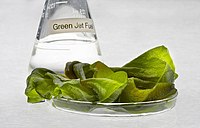
Photo from wikipedia
Background: Microalgae have the potential to generate high-value products. The design of photobioreactors (PBRs), in which microalgae are cultured, is crucial because alterations in their configuration and operational conditions can… Click to show full abstract
Background: Microalgae have the potential to generate high-value products. The design of photobioreactors (PBRs), in which microalgae are cultured, is crucial because alterations in their configuration and operational conditions can affect the biomass production and productivity. Objective: The objective of this study was to optimize the diameter of the internal tube of an airlift PBR and to characterize the growth of Spirulina maxima in an optimized design. Material and Methods: S. maxima was cultured in a mineral medium without an organic carbon source. The PBR consisted of an acrylic cylinder with an operational volume of 7 L. Daily determinations of biomass (by filtration), chlorophyll, N-NO3 and P-PO4 (spectrophotometrically) were carried out. Results: The use of a concentric tube with a diameter of 3 inches led to an increased biomass concentration of 1.14 ± 0.136 g.L-1, allowing a global biomass productivity of 153 mg.L-1.d-1. The culture reached a volumetric consumption velocity of 27.34 ± 1.596 and 2.29 ± 0.353 mg.L-1.d-1 for N and P, respectively. Conclusions: It was concluded that operational conditions must be specifically selected for each cultivated strain and that this configuration of airlift PBR can produce Spirulina biomass under laboratory conditions with a high biomass productivity.
Journal Title: Iranian Journal of Biotechnology
Year Published: 2022
Link to full text (if available)
Share on Social Media: Sign Up to like & get
recommendations!